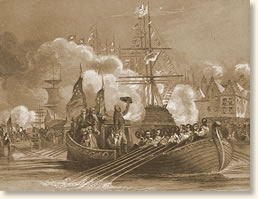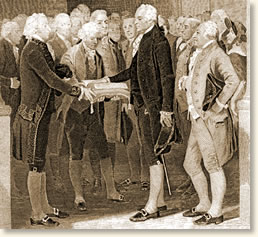|
The Inauguration of
George Washington, 1789
The Constitution of the United States was ratified
by the states in June 1788. In February of the following year the new nation's
Electoral College selected George Washington to be its first president. On April
16, 1789 Washington began the journey from his home at Mount Vernon to New York
City, then the nation's capital, where he would be inaugurated. Washington was
reluctant to leave the serenity of his home and uncertain about his new position.
His journal entry for that day noted:
"About 10 o'clock I bade adieu to Mount Vernon, to private life, and to domestic felicity, and with a mind oppressed with more anxious and painful sensations than I have words to express, set out for New York in company with Mr. Thompson, and Colonel Humphries, with the best dispositions to render service to my country in obedience to its call, but with less hope of answering its expectations." |
His journey to New York City took seven days and was transformed into a triumphal
procession by the crowds and local officials who greeted the new president
along the way. Celebrations erupted at numerous towns along his route including
Alexandria, Baltimore, Wilmington, Philadelphia and Trenton. Washington arrived
at Elizabeth Town, NJ on April 23 where a ceremonial barge awaited to take
him across the river to Manhattan.
Rudolph Von Dorsten was the Secretary of the Dutch Legation in New York City and describes Washington's entrance into the city:
"President George Washington made his entry into New York on Thursday, April 23d. On the previous day a barge left this city. The barge was built expressly by the citizens of New York, and was rowed by thirteen pilots, all dressed in white. A committee of three Senators and five Representatives on behalf of Congress, and three of the first officers on behalf of New York, went to Elizabethtown in New Jersey, to welcome the President, and to await his arrival there. His Excellency was also accompanied by some well-equipped sloops and by a multitude of small craft with citizens of New Jersey and New York on board.
A Spanish royal packet-boat, happening to be anchored at the entrance of the harbor, at sight of the barge, on board of which was
 |
| Washington crosses to New York |
the President, fired a signal-shot, whereupon that vessel was dressed at once with the flags of all nations. When the presidential barge passed, the Spanish vessel saluted his Excellency by firing thirteen guns, which was repeated by the Battery, and again thirteen guns were fired by the fort when the President landed.
His Excellency was received by Governor George Clinton, the mayor of the city and other officers, and, after a procession had formed, consisting of some companies of uniformed citizens and the merchants and other citizens of the city, the President walked with his escort and, Governor Clinton at his side, to the house prepared by Congress for his use."
Washington remained at his New York residence for a week while the House and
the Senate ironed out their differences over how the formal inauguration should
be conducted. Finally, on April 30, Washington was escorted to Federal Hall on
Wall Street and into the Senate Chamber. Washington, Vice President John Adams,
the Senators and Representatives stepped out of the chamber onto a balcony overlooking
the street filled with a cheering crowd. As there were as yet no Supreme Court
Justices, the Oath of Office was administered by Chancellor Robert R. Livingstone
- New York's highest ranking judge. After taking the oath, Washington and the
others returned to the Senate Chamber where the new president gave a short speech.
William Maclay was a farmer, a lawyer and one of Pennsylvania's Senators. He kept a diary of his experiences. We pick up his story as Washington arrives at the Senate Chamber:
"The President advanced between the Senate and Representatives, bowing to each. He was placed in the chair by the Vice-President; the Senate with their president on the right, the Speaker and the Representatives on his left. The Vice-President rose and addressed a short sentence to him. The import of it was that he should now take the oath of office as President. He seemed to have forgot half what he was to say, for he made a dead pause and stood for some time, to appearance, in a vacant mood. He finished with a formal bow, and the President was conducted out of the middle window into the gallery, and the
 |
| Washington takes the oath |
oath was administered by the Chancellor. Notice that the business done was communicated to the crowd by proclamation, etc., who gave three cheers, and repeated it on the President bowing to them.
As the company returned into the Senate chamber, the President took the, chair and the Senators and Representatives, their seats. He rose, and all arose also, and addressed them. This great man was agitated and embarrassed more than ever he was by the leveled cannon or pointed musket. He trembled, and several times could scarce make out to read, though it must be supposed he had often read it before.
He put part of the fingers of his left hand into the side of what I think the tailors call the faIl of the breeches (corresponding to the modern side-pocket), changing the paper into his left (right) hand. After some time he then did the same with some of the fingers of his right hand.
When he came to the words all the world, he made a flourish with his right hand, which left rather an ungainly impression. I sincerely, for my part, wished all set ceremony in the hands of the dancing-masters, and that this first of men had read off his address in the plainest manner, without ever taking his eyes from the paper, for I felt hurt that he was not first in everything.
He was dressed in deep brown, with metal buttons, with an eagle on them, white stockings, a. bag, and sword."
References:
Van Dorsten's account was first published in Clarence Bowen (ed.) The History of the Centennial Celebration of the Inauguration of George Washington as First President of the United States (1892) republished in Paul Angle (ed.) The American Reader (1958); Senator Maclay's account appears in Bowling, Kenneth, Helen Vent (eds.) The Diary of William Maclay (1988); Jackson, Donald (ed) The Diaries of George Washington (1976-1979); Schecter, Stephen L. and Richard Bernstein (eds.) Well Begun: Chronicles of the Early National Period (1989).
How To Cite This Article:
"The Inauguration of George Washington, 1789," EyeWitness to History, www.eyewitnesstohistory.com
(2005).
|






